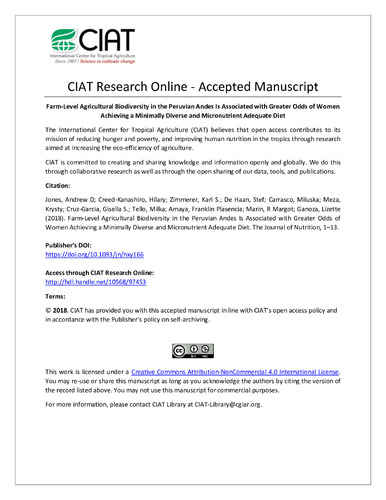Farm-Level Agricultural Biodiversity in the Peruvian Andes Is Associated with Greater Odds of Women Achieving a Minimally Diverse and Micronutrient Adequate Diet
Abstract
Abstract
Background
The extent to and mechanisms by which agricultural biodiversity may influence diet diversity and quality among women are not well understood.
Objectives
We aimed to 1) determine the association of farm-level agricultural biodiversity with diet diversity and quality among women of reproductive age in Peru and 2) determine the extent to which farm market orientation mediates or moderates this association.
Methods
We surveyed 600 households with the use of stratified random sampling across 3 study landscapes in the Peruvian Andes with diverse agroecological and market conditions. Diet diversity and quality among women were assessed by using quantitative 24-h dietary recalls with repeat recalls among 100 randomly selected women. We calculated a 10-food group diet diversity score (DDS), the Minimum Dietary Diversity for Women (MDD-W) indicator, probability of adequacy (PA) of 9 micronutrients by using a measurement-error model approach, and mean PA (MPA; mean of PAs for all nutrients). Agricultural biodiversity was defined as a count of crop species cultivated by the household during the 2016–2017 agricultural season.
Results
In regression analyses adjusting for sociodemographic and agricultural characteristics, farm-level agricultural biodiversity was associated with a higher DDS (incidence rate ratio from Poisson regression: 1.03; P < 0.05) and MPA (ordinary least-squares β-coefficient: 0.65; P < 0.1) and higher odds of achieving a minimally diverse diet (MDD-W: OR from logistic regression: 1.17; 95% CI: 1.11, 1.23) and a diet that met a minimum threshold for micronutrient adequacy (MPA >60%: OR: 1.21; 95% CI: 1.10, 1.35). Farm market orientation did not consistently moderate these associations, and in path analyses we observed no consistent evidence of mediation of these associations by farm market orientation.
Conclusions
Farm-level agricultural biodiversity was associated with moderately more diverse and more micronutrient-adequate diets among Peruvian women. This association was consistent across farms with varying levels of market orientation, although agricultural biodiversity likely contributed to diets principally through subsistence consumption.

